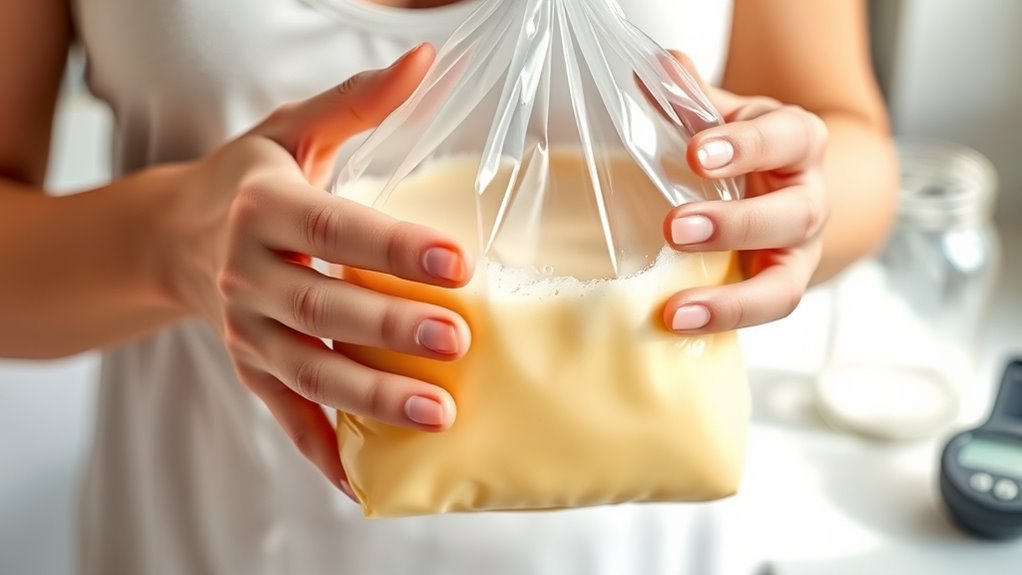Many myths about storing breastmilk aren’t true. You don’t have to use it immediately; you can refrigerate for up to 4 days or freeze for 6 to 12 months without losing nutrients. Safe storage containers are BPA-free plastic or glass. Breastmilk at room temperature for up to 4 hours is safe, and thawed milk still preserves most of its nutrients. Whether you warm it or feed it cold, understanding these facts helps keep your baby safe and happy.
Key Takeaways
- Breastmilk can be stored at room temperature for up to 4 hours safely, debunking the myth that it must be used immediately.
- Freezing breastmilk preserves nutrients effectively for 6 to 12 months, contrary to beliefs that freezing diminishes its benefits.
- Both cold and warmed breastmilk are safe for feeding, challenging the idea that milk must always be heated before offering to the baby.
- Using BPA-free, food-grade containers ensures safety and maintains milk quality, dispelling concerns about harmful chemicals in storage equipment.
- Proper handling, storage, and thawing practices are crucial for safety and nutrition, even if some myths suggest otherwise.
Common Misconception: Breastmilk Must Be Used Immediately
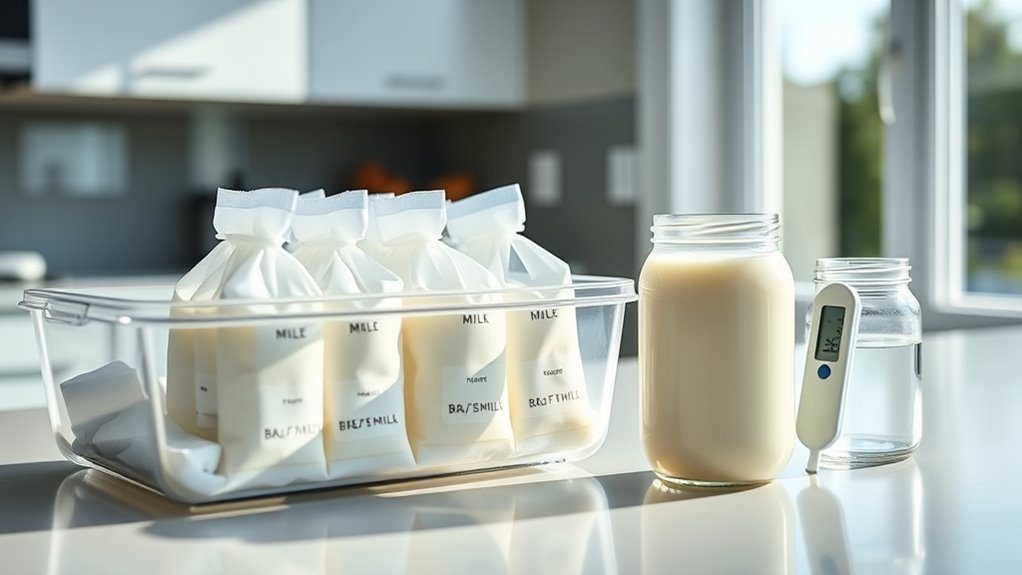
Many new parents believe they must use freshly expressed breastmilk right away, but this isn’t true. While fresh milk is ideal, you don’t have to feed it immediately after expressing. You can store it safely for later use, which offers flexibility and convenience. If you’re not ready to feed your baby right away, you can refrigerate the milk for up to four days or freeze it for longer storage. Proper storage containers and hygiene practices are essential to maintain milk quality. Additionally, understanding proper storage techniques can help preserve the milk’s nutrients and safety. Just remember, handling and storing expressed milk correctly helps preserve its nutrients and safety. So, don’t stress if you can’t feed your baby immediately. With proper storage, your breastmilk remains a safe and nourishing option whenever your little one needs it.
The Truth About Freezing Breastmilk
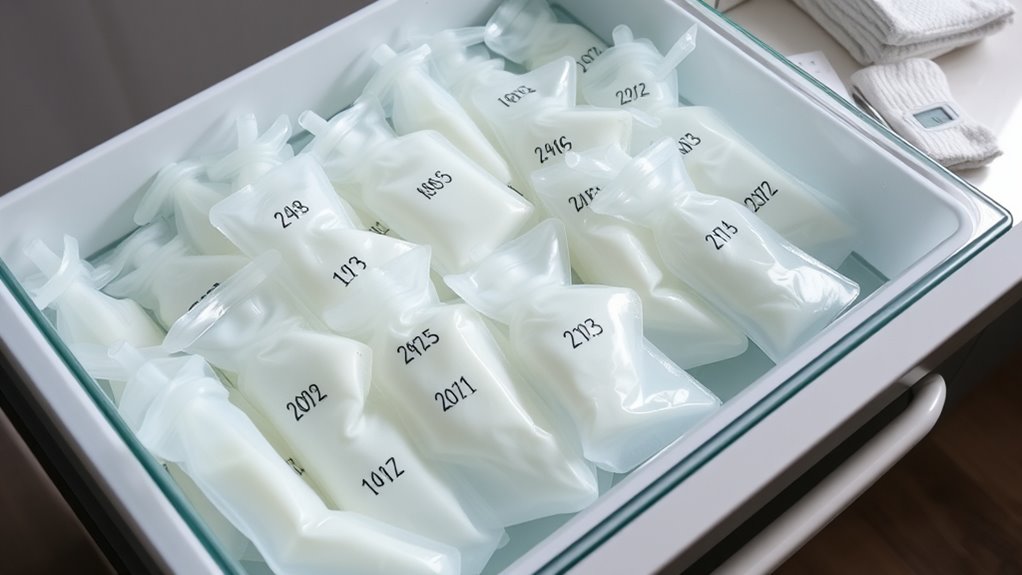
Freezing breastmilk helps preserve its nutrients, but it’s important to know how long you can store it safely. Proper thawing techniques ensure your baby gets the best quality milk without risking contamination. Understanding these facts can make freezing a reliable option for your milk supply. Additionally, avoid using spoiled lemon juice or other compromised ingredients when preparing feeding supplies to ensure safety.
Freezing Preserves Nutrients
Freezing breastmilk is often thought to destroy its nutrients, but in reality, it helps preserve most of them effectively. When you freeze milk promptly after pumping, it locks in essential nutrients like vitamins, enzymes, and antibodies, preventing their breakdown. Properly stored, frozen breastmilk retains its nutritional quality for months, ensuring your baby receives crucial nourishment. Freezing slows down bacterial growth and enzyme activity that could degrade milk over time. Proper storage techniques are vital for maintaining the quality of frozen breastmilk and maximizing its nutritional benefits. While some sensitive nutrients, such as certain vitamins, may slightly diminish with extended freezing, the overall nutritional value remains high. It’s a reliable way to keep breastmilk fresh and nutrient-rich until your baby is ready to feed. So, freezing isn’t a nutrient destroyer—it’s a preservation method that helps maintain breastmilk’s benefits.
Storage Duration Limits
How long can you safely store breastmilk in the freezer without compromising its quality? Generally, it’s best to use it within 6 to 12 months for ideal nutrition and safety. Most guidelines recommend storing breastmilk at 0°F (-18°C) or colder for up to 6 months, but it can be kept up to 12 months if your freezer maintains a consistent temperature. Beyond this, the milk may start to lose nutrients, develop freezer burn, or accumulate off-flavors. Using proper containers, like breastmilk storage bags or hard, airtight containers, helps maintain quality over time. Remember, the longer the storage duration, the higher the risk of deterioration—you’ll want to plan your freezer stock accordingly. Keeping track of storage dates ensures your baby gets the best from every feed. Additionally, understanding storage duration limits can help prevent repeated cycles of thawing and refreezing, which may further compromise milk quality.
Thawing Safety Tips
Once you’ve stored breastmilk properly, ensuring its safety during thawing is just as important. Always thaw milk in the refrigerator overnight or place the sealed container in lukewarm water. Avoid using a microwave, as it can create hot spots that burn your baby’s mouth and degrade nutrients. Never refreeze thawed breastmilk; once it’s thawed, use it within 24 hours. Keep the milk in a clean, sealed container to prevent contamination. Gently swirl, don’t shake, to mix fat layers that may have separated. Check the temperature before feeding—milk should be warm but not hot. If the milk has an off smell or appearance, discard it. Following these tips helps preserve milk quality and keeps your baby safe. Additionally, understanding color accuracy in the storage process can help maintain the milk’s nutritional value and visual quality over time.
Are Plastic Containers Safe for Storage?
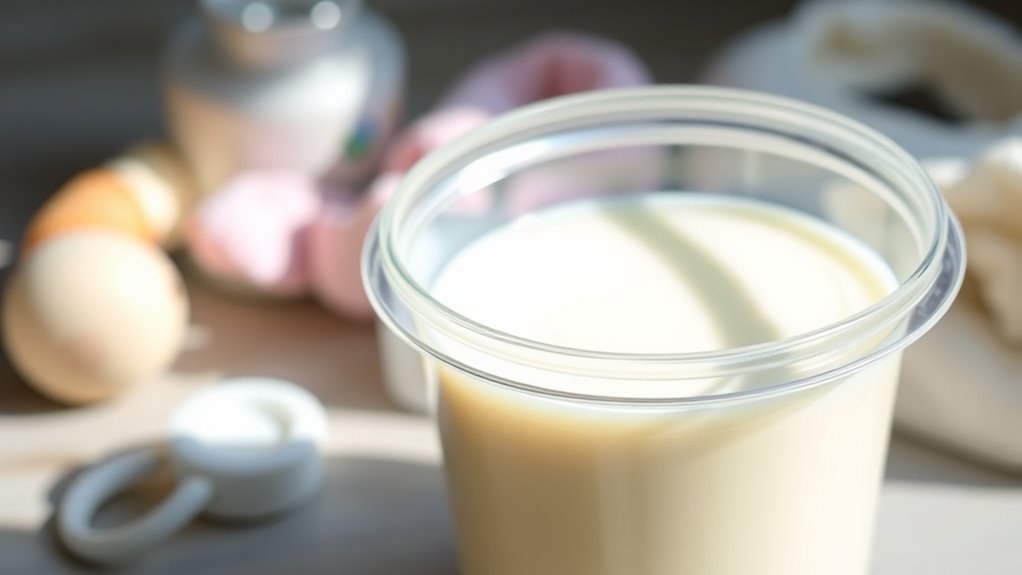
Many parents wonder if plastic containers are safe for storing breastmilk, and the answer depends on the type of plastic used. Look for containers labeled as BPA-free, as BPA (bisphenol A) can leach into milk and pose health risks. Some plastics contain other harmful chemicals, so it’s vital to check for food-grade, microwave-safe, and freezer-safe labels. Avoid containers made from generic or non-specific plastics, especially if they feel sticky or are discolored, as these may contain unsafe chemicals. Glass containers are a safe alternative if you’re concerned about plastics. Always wash plastic containers thoroughly with soap and hot water before use, and avoid microwaving milk in plastic to minimize chemical leaching. Properly chosen containers help ensure your breastmilk remains safe and healthy for your little one. Regular inspection of containers and adherence to wood stove safety guidelines can help prevent accidents or contamination.
How Long Can Breastmilk Be Stored at Room Temperature?
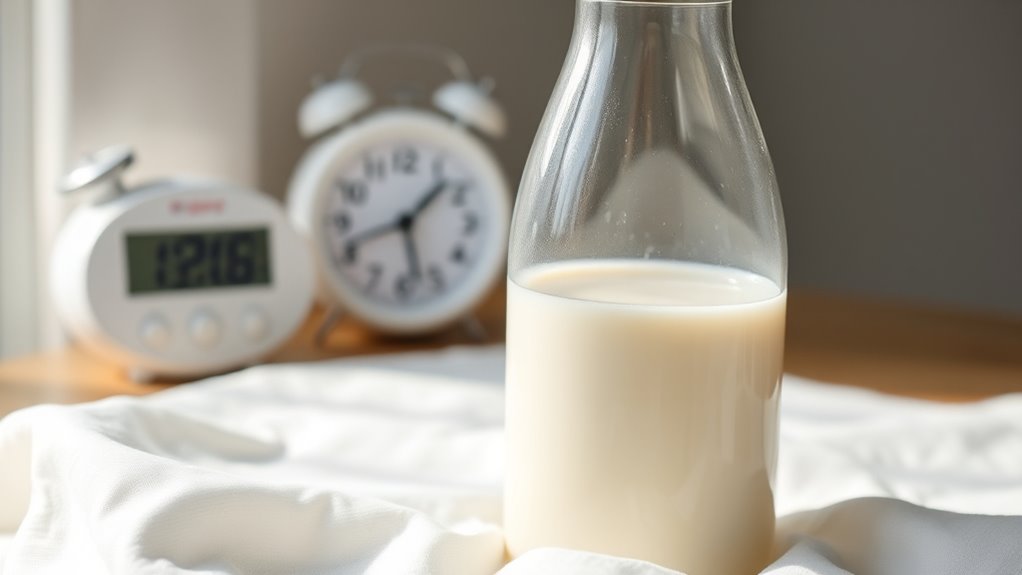
Proper storage of breastmilk begins with choosing safe containers, but knowing how long the milk stays fresh at room temperature is equally important. Typically, freshly expressed breastmilk can be kept at room temperature (up to 77°F or 25°C) for about 4 hours. Beyond this time, bacteria can start to grow, increasing the risk of spoilage. If your environment is warmer, it’s best to refrigerate or use the milk sooner. If you won’t feed the milk within 4 hours, consider refrigerating it immediately. Keep the milk in a clean, airtight container to slow bacterial growth. Remember, always check the milk’s smell and appearance before feeding—if it smells sour or looks off, discard it. Proper storage helps ensure your baby gets safe, nutritious milk every time. Using appropriate containers can also help maintain milk quality and safety during storage.
Does Thawing Affect Breastmilk’s Nutritional Value?
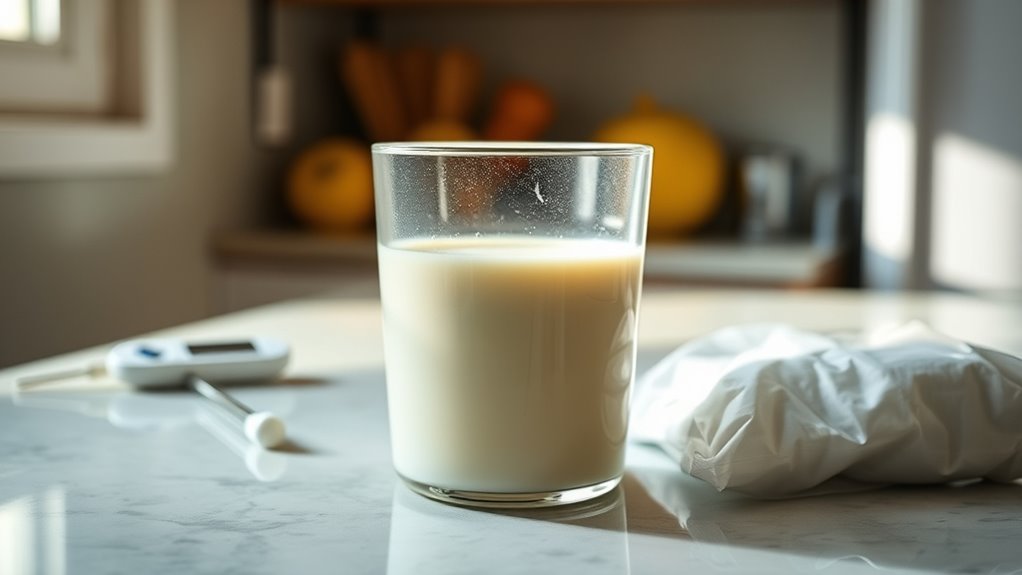
Thawing breastmilk carefully helps preserve its nutritional quality. When you thaw milk properly, you minimize nutrient loss and maintain its beneficial properties. Quick or improper thawing methods, like boiling or using hot water, can degrade some nutrients. To keep breastmilk as nutritious as possible, follow these tips:
- Thaw in the refrigerator overnight or in a bowl of warm water
- Avoid microwave heating, which can create hot spots and destroy nutrients
- Gently swirl the milk to mix layers without shaking vigorously
- Use thawed milk within 24 hours
- Do not refreeze thawed milk, as this can affect its quality
- Proper thawing techniques can help maintain the nutritional integrity of breastmilk, ensuring your baby receives maximum benefits.
Proper thawing ensures your baby receives the maximum nutritional benefits from breastmilk.
Is It Necessary to Reheat Breastmilk Before Feeding?
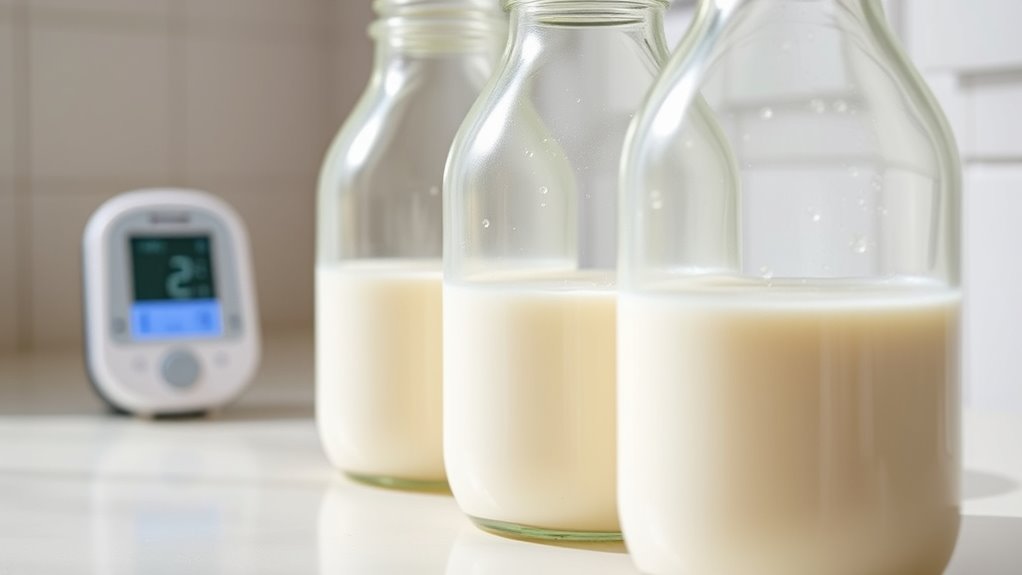
You don’t always need to reheat breastmilk before feeding. If your baby prefers it at room temperature or slightly warmed, you can feed it directly from the fridge or after warm-up. Reheating isn’t essential for safety or nutrition if the milk was stored properly and hasn’t been left out too long. If you choose to warm it, use a gentle method like placing the container in warm water or using a bottle warmer. Avoid microwave heating, as it can create hot spots and destroy nutrients. Remember, feeding your baby cold or room temperature milk is safe and often more convenient. Trust your instincts and your baby’s preferences, knowing that keeping the milk at the right temperature isn’t always necessary. Additionally, understanding AI safety concerns related to storage devices can help ensure your equipment remains reliable and secure.
Frequently Asked Questions
Can I Mix Fresh and Thawed Breastmilk?
You can mix fresh and thawed breastmilk, but it’s best to do so carefully. Always add the thawed milk to the fresh milk, not the other way around, to prevent bacterial contamination. Make sure both are at similar temperatures before mixing. Use the combined milk within 24 hours if stored in the refrigerator, and avoid mixing milk that has been stored for different lengths of time or at different temperatures.
How Do I Recognize Spoiled Breastmilk?
Spoiled breastmilk can be a nightmare, but spotting it is easier than you think. If it smells sour or rancid, it’s a clear sign it’s gone bad. Look for a change in color or texture, and if it tastes off or you notice anything unusual, trust your instincts and discard it. Always store breastmilk properly, and when in doubt, it’s safer to toss it than risk your baby’s health.
Is Breastmilk Safe to Refreeze After Thawing?
You might wonder if you can refreeze breastmilk after thawing. It’s generally safe if you haven’t fed directly from the bottle and the milk has been kept at the right temperature. Once thawed, use the milk within 24 hours and avoid refreezing. Always check for any signs of spoilage before feeding. Refreezing is best avoided, but if necessary and proper precautions are followed, it’s safe.
What Are the Best Storage Temperatures for Breastmilk?
Oh, the thrill of figuring out the perfect storage temp for your precious milk! You should keep freshly expressed breastmilk at 1-4°C (that’s about 34-39°F) in the fridge, and if you’re freezing it, aim for -18°C (0°F) or colder. This keeps bacteria at bay and nutrients intact. Remember, warmer temps invite spoilage, so don’t get too cozy with those warm milk storage adventures.
Can I Store Breastmilk in Glass Containers Instead of Plastic?
You can definitely store breastmilk in glass containers instead of plastic. Glass is safe, non-toxic, and doesn’t contain BPA or other chemicals that might leach into the milk. Plus, it’s easy to clean and doesn’t stain or retain odors. Just make sure to use containers with tight-fitting lids and leave some space at the top for expansion if freezing. Glass containers are a great, safe alternative for storing your breastmilk.
Conclusion
Now you see, storing breastmilk isn’t a tightrope walk; it’s more like tending a garden. With the right knowledge, you can nurture your milk’s freshness without unnecessary worries. Freezing, safe containers, and proper thawing become your tools—like a gardener’s hands, gentle yet effective. Trust what you’ve learned, and your milk will stay nourishing and safe, just like a well-tended plant thriving in its perfect environment.
